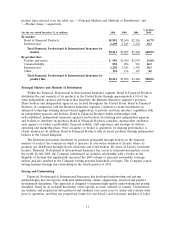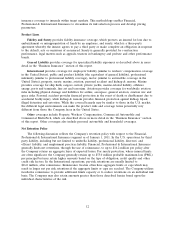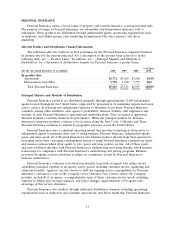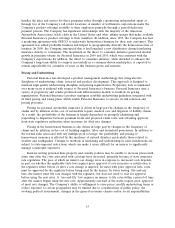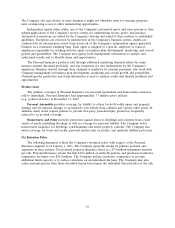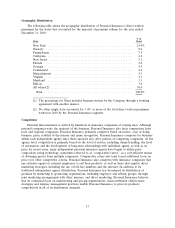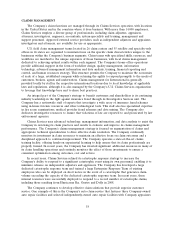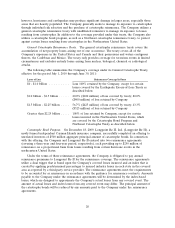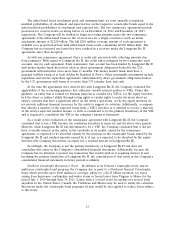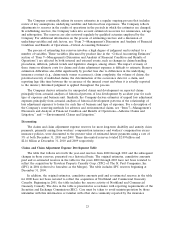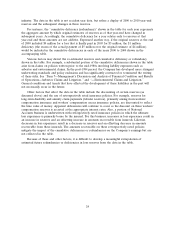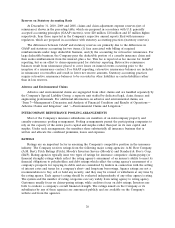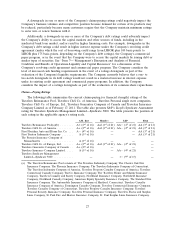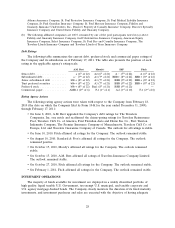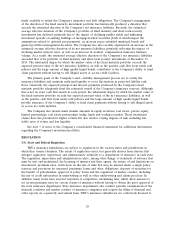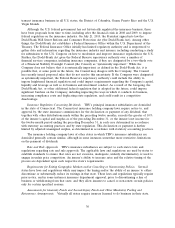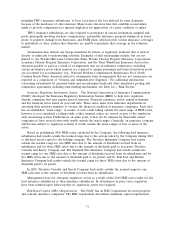Travelers 2010 Annual Report Download - page 33
Download and view the complete annual report
Please find page 33 of the 2010 Travelers annual report below. You can navigate through the pages in the report by either clicking on the pages listed below, or by using the keyword search tool below to find specific information within the annual report.The index-based losses attachment point and maximum limit are reset annually to maintain
modeled probabilities of attachment and expected loss on the respective catastrophe bonds equal to the
initial modeled probabilities of attachment and expected loss. The two reinsurance agreements provide
protection for covered events occurring before or on December 18, 2012 and December 18, 2013,
respectively. The Company will be entitled to begin recovering amounts under the two reinsurance
agreements if the index-based losses in the covered area for a single occurrence reach an initial
attachment amount of $2.250 billion. The full $250 million coverage amount of each agreement is
available on a proportional basis until index-based losses reach a maximum $2.850 billion limit. The
Company has not incurred any losses that have resulted in a recovery under the Longpoint Re II
agreements since their inception.
As with any reinsurance agreement, there is credit risk associated with collecting amounts due
from reinsurers. With regard to Longpoint Re II, the credit risk is mitigated by two reinsurance trust
accounts, one for each agreement. Each reinsurance trust account has been funded by Longpoint Re II
with money market funds that invest solely in direct government obligations backed by the U.S.
government with maturities of no more than 13 months. The money market funds must have a
principal stability rating of at least AAAm by Standard & Poor’s. Other permissible investments include
repurchase and reverse repurchase agreements collateralized by direct government obligations backed
by the U.S. government with terms of no more than 397 calendar days, and cash.
At the time the agreements were entered into with Longpoint Re II, the Company evaluated the
applicability of the accounting guidance that addresses variable interest entities or VIEs. Under this
guidance, an entity that is formed for business purposes is considered a VIE if: (a) the equity investors
lack the direct or indirect ability through voting rights or similar rights to make decisions about an
entity’s activities that have a significant effect on the entity’s operations, or (b) the equity investors do
not provide sufficient financial resources for the entity to support its activities. Additionally, a company
that absorbs a majority of the expected losses from a VIE’s activities or is entitled to receive a majority
of the entity’s expected residual returns, or both, is considered to be the primary beneficiary of the VIE
and is required to consolidate the VIE in the company’s financial statements.
As a result of the evaluation of the reinsurance agreement with Longpoint Re II, the Company
concluded that it was a VIE because the conditions described in items (a) and (b) above were present.
However, while Longpoint Re II was determined to be a VIE, the Company concluded that it did not
have a variable interest in the entity, as the variability in its results, caused by the reinsurance
agreements, is expected to be absorbed entirely by the investors in the catastrophe bonds issued by the
Longpoint Re II and residual amounts earned by it, if any, are expected to be absorbed by the equity
investors (the Company has neither an equity nor a residual interest in Longpoint Re II).
Accordingly, the Company is not the primary beneficiary of Longpoint Re II and does not
consolidate that entity in the Company’s consolidated financial statements. Additionally, because the
Company has no intention to pursue any transaction that would result in it acquiring interest in and
becoming the primary beneficiary of Longpoint Re II, the consolidation of that entity in the Company’s
consolidated financial statements in future periods is unlikely.
Northeast Catastrophe Reinsurance Treaty. In addition to its General Catastrophe treaty and its
multi-year catastrophe bond program, the Company also is party to a Northeast General Catastrophe
treaty which provides up to $600 million of coverage, subject to a $2.25 billion retention, for losses
arising from hurricanes, earthquakes and winter storm or freeze losses from Virginia to Maine for the
period July 1, 2010 through June 30, 2011. Losses from a covered event (occurring over several days)
anywhere in the United States, Canada, the Caribbean and Mexico may be used to satisfy the retention.
Recoveries under the catastrophe bond programs (if any) would be first applied to reduce losses subject
to this treaty.
21


